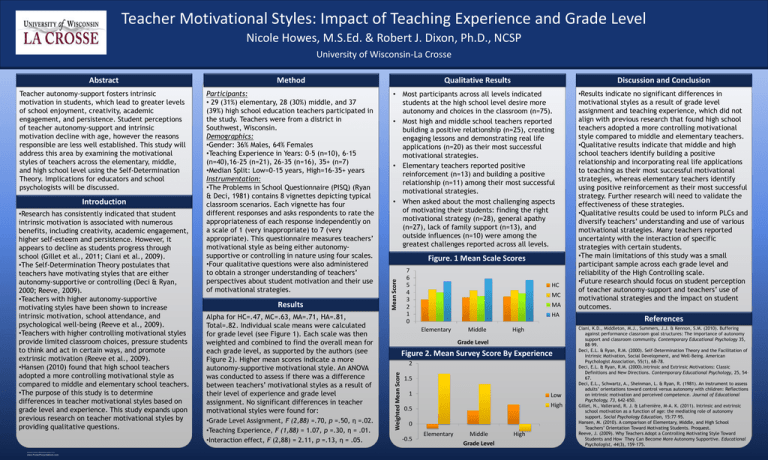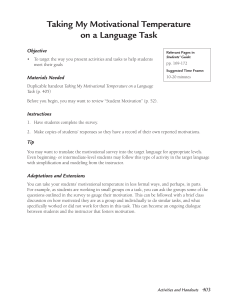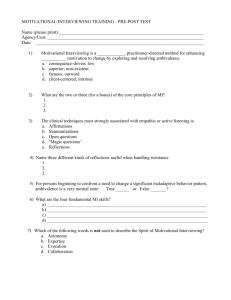QUICK DESIGN GUIDE
advertisement

Teacher Motivational Styles: Impact of Teaching Experience and Grade Level Nicole Howes, M.S.Ed. & Robert J. Dixon, Ph.D., NCSP University of Wisconsin-La Crosse Teacher autonomy-support fosters intrinsic motivation in students, which lead to greater levels of school enjoyment, creativity, academic engagement, and persistence. Student perceptions of teacher autonomy-support and intrinsic motivation decline with age, however the reasons responsible are less well established. This study will address this area by examining the motivational styles of teachers across the elementary, middle, and high school level using the Self-Determination Theory. Implications for educators and school psychologists will be discussed. Participants: • 29 (31%) elementary, 28 (30%) middle, and 37 (39%) high school education teachers participated in the study. Teachers were from a district in Southwest, Wisconsin. Demographics: •Gender: 36% Males, 64% Females •Teaching Experience in Years: 0-5 (n=10), 6-15 (n=40),16-25 (n=21), 26-35 (n=16), 35+ (n=7) •Median Split: Low=0-15 years, High=16-35+ years Instrumentation: •The Problems in School Questionnaire (PISQ) (Ryan & Deci, 1981) contains 8 vignettes depicting typical classroom scenarios. Each vignette has four different responses and asks respondents to rate the appropriateness of each response independently on a scale of 1 (very inappropriate) to 7 (very appropriate). This questionnaire measures teachers’ motivational style as being either autonomysupportive or controlling in nature using four scales. •Four qualitative questions were also administered to obtain a stronger understanding of teachers’ perspectives about student motivation and their use of motivational strategies. Introduction •Research has consistently indicated that student intrinsic motivation is associated with numerous benefits, including creativity, academic engagement, higher self-esteem and persistence. However, it appears to decline as students progress through school (Gillet et al., 2011; Ciani et al., 2009). •The Self-Determination Theory postulates that teachers have motivating styles that are either autonomy-supportive or controlling (Deci & Ryan, 2000; Reeve, 2009). •Teachers with higher autonomy-supportive motivating styles have been shown to increase intrinsic motivation, school attendance, and psychological well-being (Reeve et al., 2009). •Teachers with higher controlling motivational styles provide limited classroom choices, pressure students to think and act in certain ways, and promote extrinsic motivation (Reeve et al., 2009). •Hansen (2010) found that high school teachers adopted a more controlling motivational style as compared to middle and elementary school teachers. •The purpose of this study is to determine differences in teacher motivational styles based on grade level and experience. This study expands upon previous research on teacher motivational styles by providing qualitative questions. RESEARCH POSTER PRESENTATION DESIGN © 2012 www.PosterPresentations.com Results Alpha for HC=.47, MC=.63, MA=.71, HA=.81, Total=.82. Individual scale means were calculated for grade level (see Figure 1). Each scale was then weighted and combined to find the overall mean for each grade level, as supported by the authors (see Figure 2). Higher mean scores indicate a more autonomy-supportive motivational style. An ANOVA was conducted to assess if there was a difference between teachers’ motivational styles as a result of their level of experience and grade level assignment. No significant differences in teacher motivational styles were found for: •Grade Level Assignment, F (2,88) =.70, p =.50, η =.02. •Teaching Experience, F (1,88) = 1.07, p =.30, η = .01. •Interaction effect, F (2,88) = 2.11, p =.13, η = .05. Qualitative Results Discussion and Conclusion • Most participants across all levels indicated students at the high school level desire more autonomy and choices in the classroom (n=75). • Most high and middle school teachers reported building a positive relationship (n=25), creating engaging lessons and demonstrating real life applications (n=20) as their most successful motivational strategies. • Elementary teachers reported positive reinforcement (n=13) and building a positive relationship (n=11) among their most successful motivational strategies. • When asked about the most challenging aspects of motivating their students: finding the right motivational strategy (n=28), general apathy (n=27), lack of family support (n=13), and outside influences (n=10) were among the greatest challenges reported across all levels. Figure. 1 Mean Scale Scores Mean Score Method 7 6 5 4 3 2 1 0 HC MC MA HA Elementary Middle High Grade Level Figure 2. Mean Survey Score By Experience 2 Weighted Mean Score Abstract 1.5 1 Low High 0.5 0 -0.5 Elementary Middle Grade Level High •Results indicate no significant differences in motivational styles as a result of grade level assignment and teaching experience, which did not align with previous research that found high school teachers adopted a more controlling motivational style compared to middle and elementary teachers. •Qualitative results indicate that middle and high school teachers identify building a positive relationship and incorporating real life applications to teaching as their most successful motivational strategies, whereas elementary teachers identify using positive reinforcement as their most successful strategy. Further research will need to validate the effectiveness of these strategies. •Qualitative results could be used to inform PLCs and diversify teachers’ understanding and use of various motivational strategies. Many teachers reported uncertainty with the interaction of specific strategies with certain students. •The main limitations of this study was a small participant sample across each grade level and reliability of the High Controlling scale. •Future research should focus on student perception of teacher autonomy-support and teachers’ use of motivational strategies and the impact on student outcomes. References Ciani, K.D., Middleton, M.J., Summers, J.J. & Kennon, S.M. (2010). Buffering against performance classroom goal structures: The importance of autonomy support and classroom community. Contemporary Educational Psychology 35, 88–99. Deci, E.L. & Ryan, R.M. (2000). Self-Determination Theory and the Facilitation of Intrinsic Motivation, Social Development, and Well-Being. American Psychologist Association, 55(1), 68-78. Deci, E.L. & Ryan, R.M. (2000).Intrinsic and Extrinsic Motivations: Classic Definitions and New Directions. Contemporary Educational Psychology, 25, 54– 67. Deci, E.L., Schwartz, A., Sheinman, L. & Ryan, R. (1981). An instrument to assess adults’ orientations toward control versus autonomy with children: Reflections on intrinsic motivation and perceived competence. Journal of Educational Psychology, 73, 642-650. Gillet, N., Vallerand, R. J. & Lafrenière, M-A. K. (2011). Intrinsic and extrinsic school motivation as a function of age: the mediating role of autonomy support. Social Psychology Education, 15:77–95. Hansen, M. (2010). A comparison of Elementary, Middle, and High School Teachers’ Orientation Toward Motivating Students. Proquest. Reeve, J. (2009). Why Teachers Adopt a Controlling Motivating Style Toward Students and How They Can Become More Autonomy Supportive. Educational Psychologist, 44(3), 159–175.




